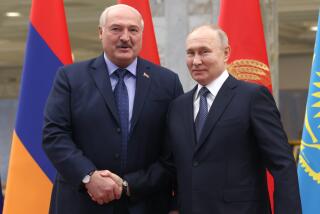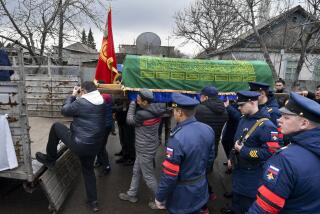Ill Children in Kyrgyzstan Used as Pawns
- Share via
BELOVODSK, Kyrgyzstan — One child huddles in the corner of an empty room. Others grope for crumbs on the dusty floor. All of them are naked and very thin. Wordless screaming echoes behind them, and meaningless smiles play on their bruised, sore-covered faces.
These are video images shown last month on Russia’s commercial television channel, NTV. They show conditions in a home for mentally retarded children in the former Soviet republic of Kyrgyzstan.
The videotape was used not to focus on the plight of the children, but to make a political point that highlights Moscow’s jealousy of growing U.S. involvement with former Soviet republics near the oil-rich Caspian Sea.
The tape illustrated a news item denouncing Hillary Rodham Clinton’s visit to Kyrgyzstan during a November tour of republics once ruled by Moscow.
Her trip preceded the opening of an oil pipeline that will take vast reserves of Caspian crude to the West--an outcome that pleases the ex-Soviet republics and their Western partners, including U.S. oil companies, but irritates Russia.
The piece contrasted footage of the children’s home here with sunlit pictures of crates of humanitarian aid worth $2 million that the first lady brought to Kyrgyzstan and of her smiling at plump children dancing in national costume. It suggested that Kyrgyzstan had put on a colorful show to mask the appalling conditions in which many children are kept.
“Outside Bishkek [the capital], reporters found a real children’s concentration camp,” said the Moscow anchorwoman as the horrifying pictures began. Added a lugubrious male voice-over: “The fate of all these children is the same--death. One-third of them die every year.
“The problem is that Hillary’s trip was worked out on the basis of USAID information, which classifies Kyrgyzstan as the most progressive and reformist of the Central Asian republics,” the commentary continued. “This home in Belovodsk doesn’t fit that picture, so it’s unlikely that these children will see any of the $2 million in aid that Hillary brought with her.”
Conditions in many children’s homes, in Russia as well as Kyrgyzstan and other ex-Soviet republics, are bleak.
The Soviet attitude that mentally retarded children should be shut away has persisted in all parts of the vanished empire. The NTV item did not mention the similar situation in homes closer to Moscow.
Angry and humiliated by the unflattering NTV item, Kyrgyz officials say their old imperial master was deliberately trying to discredit them in U.S. eyes, to prevent Kyrgyzstan from developing an independent and friendly relationship with Washington.
“This was deliberately done in connection with Hillary Clinton’s visit, and accompanied by a very deceptive commentary,” Deputy Prime Minister Mira Dzhangaracheva said. “Russia was very worried that Hillary Clinton came to Kyrgyzstan without Moscow’s say-so.”
The incident has left a sour taste in Bishkek.
Kyrgyz President Askar A. Akayev threatened to muzzle Russian journalists working in his country. Kyrgyzstan complained to NTV; to Lars Gills, the Norwegian representative of the humanitarian group Save the Children (Denmark), who shot the tape; and to Norwegian television, where the video first aired.
Gills, who shot the tape last summer while his organization helped with repairs at the home, said he took it home on vacation and had it shown on Norwegian television in hopes of finding sponsors.
He did not know how the tape came to be released worldwide, in breach of his contract, and he was indignant that what he says was originally a serious, balanced report lasting at least 20 minutes was boiled down to about one sensational minute by NTV.
He also disowned a quotation attributed to him, spoken in Russian as his face was shown on NTV’s clip, that was translated as: “There’s nothing this bad even in starving North Korea.”
But he looked on the bright side.
“The outcome of all this is that the children are the winners,” Gills said, adding that more organizations were coming forward to help and the Kyrgyz government had been jolted into searching for new ways to do more for the children.
What worries Gills is how thin the children are.
“People are saying the children can’t absorb food because of their mental health, but there’s no connection,” he said.
The issue, however, has wounded national pride.
Kyrgyz officials banned all journalists from the Belovodsk children’s home for several days. When they finally, and reluctantly, let a reporter and photographer from The Times inside, it was only for the briefest of visits: doors flung open and quickly shut on bare wards full of sleeping children snuggled under blankets. Local and national government officials were present, along with the home’s head doctor and its director.
Photographing the children was discouraged.
“They don’t like it,” said head doctor Tatyana Shamatova, interposing herself between waking child and lens.
Indignantly, the home’s director, Maxim Elizarov, stressed that mortality rates at the neat, if shabby, home for about 170 disabled children had shrunk from 45 a year in the early 1990s to 10 so far this year. The children are fed five times a day, on meat, milk and bread, getting more than 3,000 calories each, he added.
So why were they so thin?
“It’s quite natural,” answered Shamatova with a shrug. “It’s because of their condition. We feed them and feed them, but they drop the food down themselves or dribble it on the ground.”
“It’s quite natural,” Dzhangaracheva, the deputy prime minister, later answered with another shrug. “Where have you ever seen fat idiots?”
More to Read
Sign up for Essential California
The most important California stories and recommendations in your inbox every morning.
You may occasionally receive promotional content from the Los Angeles Times.










